The Swan Inn, Hogsty End, Wavendon (now Woburn Sands)
This article is based mainly on the research work compiled by a local historian, the late Arthur Parker, in 1975-84. His local knowledge was unrivalled and I have not had the access to the deeds etc. that he did. However, we now have local and family history resources available that he would have marvelled at. We now have searchable newspaper collections, which has provided much to this story.
It is almost impossible to separate the early history of this inn from the farm it was based on. Many country inns started life as farms and in this case, it was quite a large one. Employing many men, it is easy to imagine the farmer deciding to brew his own beer so they had something to look forward to when coming in from the fields after a hard day’s work. If you make enough, you can always sell some to other thirsty locals to recoup some costs. Thus, an inn starts.
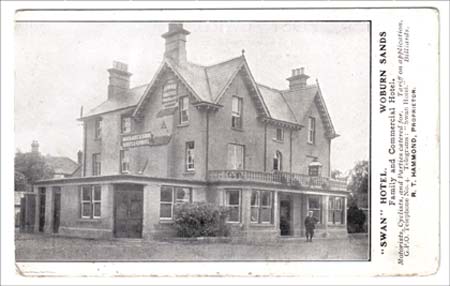
This inn may be regarded as one of the oldest and the most important of Hogsty End, as Woburn Sands was then known. However, the history is complex, as due to the fluctuations of county, parish and ecclesiastical boundaries, as well as village names, it has been referred to as being in Wavendon, Hogstye End, Woburn Sands or even Aspley Heath! There was also once a Swan Inn beer house in Bedford Road, Aspley Guise, which closed in 1909, and a Swan Inn (sometimes White Swan Inn) in Woburn, which closed before 1788. There was also a Swan Inn in Newport Pagnell, run by one of Higgins family, who later transferred his business to the Swan Inn at Woburn Sands.
The Higgins family seem to have originally come from Sherington. The original farm buildings they ran here were extensive and covered the corner of what we know as Hardwick Road. The land running with the farm covered most of the area now built over as modern Woburn Sands. The Higgins family ran the inn, off and on, through three generations, but lastly lived nearby at Greenwood Cottage, so the farm and inn was sometimes let out to tenants.
The old inn was once probably a large cottage, probably with a thatched roof, possibly later replaced with tiles. On the South and West sides of the yard were buildings, (including two cottages) and a building in which a school and church services were once held; and the rest stabling. Some of the old boundary walls against the nearest Hardwick Road house were the backs of old buildings, and are anything up to 300 years old.
It is apparent from the present inn that this is not the building that was there in the 17th or 18th centuries, and we have no old pictures or documentary evidence to tell us what the original was like. The earliest plan we have is of 1876 and this shows the inn with its two bay windows, much the same as today.
In the Autumn of 1979 the whole of the ground floor front of the hotel was gutted to form one long open bar, and amongst old timbers removed in the process were small beams which had been re-used. Old mortices holes in them had been plugged before the timber was inserted in the new building, but there was no trace of any old building remaining, to form a nucleus for the new. It must therefore be assumed that the old inn was completely demolished and the new one built on its site.
When the renovations were under way, Arthur Parker obtained the opinion of Paul Woodfield, the then Conservation Officer of the old Milton Keynes Development Corporation, in order to try and establish a date for the change. Although they could find nothing of the old building except the beams mentioned, he expressed the opinion that the current building was definitely after 1830, but not as late as 1850, so around 1840.
The earliest written evidence for the original inn comes from the Bucks Alehouse Register, but that only starts in 1753. It was then known by the sign of the “Coach and Horses”. In an early local map of 1765, the Hogsty End-part of Wavendon is clearly shown and it names two local pubs, the Coach and Horses and the White Hart, which is now the Weathercock.
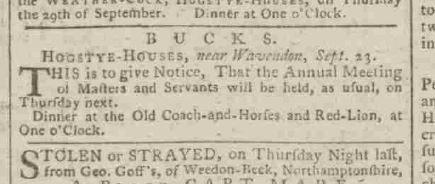
There is very little other documentary evidence for the Coach and Horses Inn, barring a few adverts in early newspapers. One such is an advert for the Statute Hiring Fair being held at “..Hogstye Houses, near Wavendon”. Here, masters and farmers gathered to hire the labourers they needed for the coming year. If you hadn’t been a good worker the year before, you didn’t get hired again! Once the business of the day was completed, everyone adjourned to the local inns for a meal. In 1785, this meal was held split between the Red Lion in the High Street (see separate page on this website) and “The Old Coach and Horses”, as neither was large enough to accommodate everybody at once.
It was obviously large enough to house quite populous meetings, as in August 1787, when the local meeting to decide how to divide up the land around Wavendon, under the national scheme for enclosure of land, was held at “..the house of Mrs Goodwin, known by the sign of the Coach and Horses, at Hogsty-End, within the parish of Wandon”. (Wandon was the old name for Wavendon, another searching complication)
In the Northants Mercury of 30th August, 1800 is a lost dog announcement. One William Dawson had lost his dog in the woods near Woburn Sands. William was from Owens Row, Islington, so perhaps he was travelling through on a coach. He asked for it to be brought to him or “to Mr Higgins, Hogsty Inn, the bottom of Woburn Sands…” for a two guinea reward. I don’t think the inn was ever officially called that, it was just being used as a geographical description.
They also held many public auctions at the inn. The first I can find is October 1801, when an auction for Aspley Guise wind & watermill was held at “…Mr Higgins’s The Coach and Horses Inn, Hogsty-End, near Woburn..”. By the time of an auction of two hunting dogs in August 1806, the address is being given as “…Coach and Horses Inn, on the Sands, near Aspley…”, but the landlords name is not given. The inn continued as an auction centre right up into the 20th century. Most local buildings have been sold there at one time or another.
By October the same year, 1806, the following advert appeared in the Northants Mercury in October: “SWAN INN, on the Sands, near Woburn, RICHARD HIGGINS, who kept the Swan Inn, Newport Pagnell, Bucks, many years, informs the Nobility, Gentlemen Travellers, and others, that, in Consequence of the Goat Inn, Woburn, being shut up, and there being only one Post-House in the Town, he has, at the particular Request and Solicitation of the Nobility, Gentlemen Travellers, whose favour and friendship he so liberally experienced during his Residence at Newport, taken upon himself the POSTING BUSINESS again; and begs Leave to assure them, every Attention and Accommodation, both in the House and Yard, will be strictly attended to. Comfortable Sleeping-Rooms and well-aired Beds, the best Wines and Spirits, and a well-supplied Larder. Post Chaises, able Horses, and careful Drivers, with Expedition. The Distance to Newport is eight Miles, and ten from Dunstable.”
It is confusing that the name the “Swan” is clearly in use here, yet the ‘official’ records of the Bucks Ale House Register continue to list it as the “Coach and Horses” until 1809. When the nearby village of Salford enclosed their land in 1808, the advert asked for interested parties to meet, at “The Swan at Hogstye-End”, at the house of Richard Higgins. I do not know the dates for the pubs in Salford; perhaps they were not yet open at this time to hold it more locally to Salford.
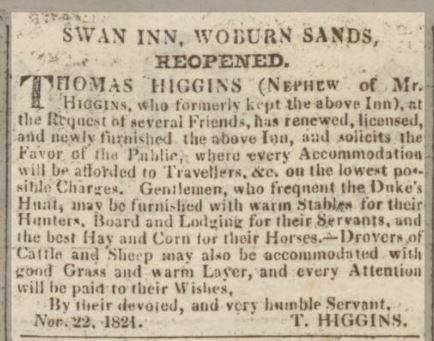
The reason for the name change is not known. Most people would think that Coach and Horses was much more appropriate for a house on the old turnpike road servicing the travellers coming through on horse drawn coaches, and there was no water nearby to attract swans, but the Swan is the heraldic sign for Buckinghamshire. Most travellers would just have come from Woburn, passing through Bedfordshire, and crossed the county boundary in the middle of The Square, on which the inn has a commanding position.
The Higgins’ bought out their neighbours, the Harts, whose farm stood about where Shelton House now is, in about 1821, and at the same time there seems to have been quite a large refurbishment, when another generation of Higgins took over the inn. From the Northants Mercury, in November: “SWAN INN, WOBURN SANDS, REOPENED. THOMAS HIGGINS (nephew of Mr Higgins, who formerly kept the above Inn), at the Request of several Friends, has renewed, licensed, and newly furnished the above Inn, and solicits the favour of the Public, where every Accommodation will be afforded to Travellers, &c. on the lowest possible Charges. Gentlemen, who frequent the Duke’s Hunt, may be furnished with warm stables for their Hunters, Board and Lodging for the Servants, and the best Hay and Corn for their Horses. – Drovers of Cattle and Sheep may also be accommodated with good Grass and warm Layer, and every Attention will be paid to their Wishes. By their devoted, and very humble Servant, T. Higgins. Nov.22 1821”
It is not known exactly how long Thomas Higgins stayed as landlord, but the next landlord was another tenant, Thomas Odams, from 1837 to 1849, although he nearly lost the inn during August 1840, according to the Northampton Mercury: “Fire – On Wednesday evening last, a fire broke out on the premises of Mr T. Odams, of the Swan Hotel, Woburn Sands. The engine of Sir Hugh Hoare, and the one from Woburn were almost immediately on the spot, and from the great activity of the bystanders it was got under after the consumption of two large stacks of stubble and a cart hovel. The fire originated from two children between five and six years of age playing with Lucifer matches.”
Fire was the most common reason that buildings had to be rebuilt. We were lucky in this area to have not one, but two fire brigades to call on. Sir Hugh Hoare was the lord of the manor at Wavendon, and part of the Hoare Bank family. Most county villages had none.
One of their later tenants in 1849-50 was Edward Emmerton. The Emmerton’s were a large family in the Wavendon area, and Edward had previously run the Leathern Bottle at Wavendon. He advertised his move in 1849 to the Swan, taking over from a Thomas Odams, and promoting his stock of Ales, Wines and Spirits. Sadly, Edward got himself into difficulties. In 1850, he turned a non-paying customer out of the Swan, (which is not an unusual occurrence for that time), but Edward used a spade to assist in the removal! The Bench took a very dim view of him using a weapon and warned him not to do so again.
Later the same year, he then allowed a prize fighter, Tom Paddock, to live and train at the inn; bare-knuckle prize fights were hugely popular at the time, although illegal. When he came to renew the inn licence in August, the Newport Pagnell bench refused to do so, saying there were “improper practices”, involving fights at the inn. Josiah Warren, a wool stapler of Newport Pagnell, gave a statement that he had been at the inn on his way to Leighton market, and had seen a fight take place between two men named Rolfe and Smith while others, including Paddock, watched. It lasted ten minutes, but the witness could not say he saw any money change hands. Another witness, Abraham Hobbs, a carpenter who lived nearby, said he heard a commotion, and saw a fight there between Paddock and a man called Kingstone, but Kingstone was soon floored, and Paddock hit him several times while he was on the ground. Hobbs said it was well known in the village that Paddock trained there. The landlords defence was that he owned some farm land in Wavendon too, and was out of his inn when these events took place. He appealed several times, but it dragged on for a couple of months, and all the time the inn could not sell alcohol.
Emmerton eventually got the inn back open, but in November he was charged with assaulting Thomas Odams, farmer, and presumably the previous landlord of the Swan. Odams said he went into the Fir Tree public-house, across the road from the Swan, when the defendant came in and “made use of very abusive language towards him, afterwards threw part of a pint of beer in his face”. Emmerton admitted the assault, and was convicted in the penalty of £1.0.0 and £1.0.0. costs.
Whatever the argument was about, it was too late to save his business and Emmerton went broke, leaving a string of bankruptcy notices in the press. The list of Emmerton’s stock and possessions, from both the inn and farm attached, that sold at auction in April 1851 by his creditors, shows what a large concern it was:
“Wavendon, Bucks, Live and Dead Farming Stock, 19 cows and sturks, 5 horses, 5 Downs Couples Pigs, Excellent Implements, Stack of Beans, Browse of Straw &c. All the neat and useful Household Furniture, Superior Large Ale Casks, Dairy and Brewing Utensils, and other Effects. To be sold by Auction by Thomas Greene On Friday April 11th 1851. At Ten o’Clock to a minute (in consequence of the number of lots) on the Premises The SWAN INN, WOBURN SANDS. By the direction of the Assignees of Mr Edward Emmerton, a Bankrupt. Comprising Three Yorkshire Cows and sixteen young Steers and Heifers; five cart horses and Hackneys; Five Down Couples Pigs &c. Capital iron-arm wagon; four iron arm carts, Harrows, Rolls, Drill, Ploughs, Harness, Hurdles, Sheep and Cattle Cribs and Troughs. Dressing Machine (by Couch) Chaff-cutting ditto, (by Hensman) Gardners Turnip Cutter, Barn Tackle &c. Six-hundred Gallon Ale Cask, two Five-hundred Gallon ditto, three-hundred-and-forty gallon ditto, pipes, hogsheads and small casks, five brewing tubs, pails, jets &c. Milk pails, milk tins, rivers 7c. Browse all of the remaining straw and a stack of beans, the produce of six acres. The household Furniture consists of four post, tent and French bedsteads and furniture; feather beds, bolsters and pillows, mattresses palisades, blankets and counterpanes, dressing tables and washstands, swing glasses, carpets, chamber chairs &c. mahogany side board, dining and other tables, stuffed seat, Windsor and other chairs, glass and earthenware, oil paintings and prints, kitchen requisites, and numerous other effects. Catalogues may be had at the place of sale; Bedford Arms, Woburn; Saracens Head, Newport Pagnell; Hop Pole Bedford, and of the Auctioneer, Ampthill.”
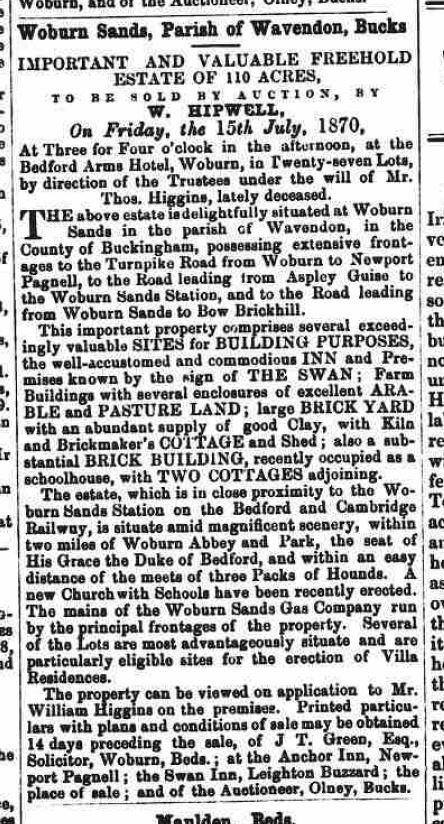
The Higgins’ had to find another tenant. When they couldn’t / didn’t find a tenant, they must have sometimes stepped in to run the pub themselves, as we know that Thomas Higgins later faced prosecution himself in 1858 for having an unjust quart measure in use at the inn. He was fined £1 2s 6d.
Certainly by 1867, the brewers, Coling & Hipwell of Olney were involved in running the inn, as in November that year they were advertising looking to let it to new tenants, with ‘Going in’ costs of £70 – £80 required.
Thomas Higgins died in 1870, and his two sons decided they had had enough of inns and farming locally in Woburn Sands, and arranged to sell up. Woburn Sands High Street had by now started to develop, and land prices must have risen dramatically. There was a grand auction of the Higgins estate at The Bedford Arms in Woburn, but only 9 of their 27 lots sold. The “well accustomed and commodious inn, and premises, known by the sign of the Swan…” and the Swan Field opposite, were among the successes, being sold to Charles Claridge, the Wavendon maltster for £720. Claridge dispensed with the services of the serving tenant, William Scriviner, and installed his own family member, George, as landlord. However, the Claridge’s only held it for six years, before selling the inn on to the Down brothers, the local entrepreneurs who ran a wheat carbolizer works, and veterinary medicines business. The story of Henry & Fred Down can be found elsewhere on this website, as they had fingers in many pies… George Claridge transferred the licence of the Swan to Zachariah Spreckley in October 1875. (Croydon’s Weekly Standard)
Two years later, the Downs also bought the old school house and cottages which stood just to the south of the inn, reuniting them with the inn. They had been sold after the unsuccessful auction, along with the major part of the rest of the estate to a Samuel Dudley of Winslow, who forthwith sold this small lot to William Stanford of Woburn, though it is not known for what purpose Stanford had used them. It is referred to as ‘old School House’ as about 1810 and for some years after, this building was used a school, run by Joseph Daniels, and, over the doorway, was the inscription “Woburn Sands Academy”. Prior to the erection of St Michael’s Church, the building was used for religious purposes as a “Chapel of Ease” of Wavendon, the church organising it as a school on weekdays, though in 1890, the Vicar of Woburn Sands, in his magazine, remarks that it is being used as a constitutional club. The Downs used them in connection with their mineral water factory, probably for storage.
Henry & Fred Down took a leading part in most local affairs and were the largest employers of local labour, and as such probably found there was a demand for a bowling green. Though there was a recreational club in Inwood’s yard, it was contained within four walls, but the Swan had very little ground available, only a narrow strip of garden running down the High Street frontage, about 30 feet wide. The Downs therefore approached their neighbour to the north, Mrs Loke, and in 1885 purchased from her part of her garden which had the old farm buildings still standing on it. The ground was raised and levelled and the bowling green laid out, though it only ran the standard 40yds in one direction.
In 1888, the Downs were responsible for the first ever travelling circus visit to Woburn Sands, when Robert Fossetts’ Circus came and camped on Swan Field, opposite, at their request.
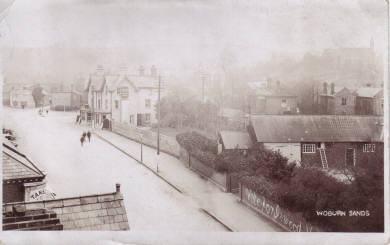
The elder Down brother, Henry, died in 1891, and his younger brother Frederick lost no time in going into partnership with William Needham, the local ironmonger. They extended their business empire in pubs and mineral waters, building a small but geographically widespread chain, but on the last day of 1895, the Down sold the Swan to the Northampton brewers, P. Phipps & Co., and so it passed out of local ownership. On the deed is a very good plan, though it includes the barn which by this time must have been pulled down. On the other hand, there is an alteration in the cottage block, the East end of which is now shown 30 feet deep, and marked “Social Club”. It is therefore evident that they had pulled down the old school-cum-factory and erected an entirely new building, probably soon after their purchase in 1878. The 1880 Ordnance Survey map shows the old narrow building. Arthur Parkers opinion of this is based on the fact that Fred Down built variously around the village, and in most cases in imitation style. The gable end of the new building was a replica of the Italian-style ornate top of Needham’s mineral water factory at the start of Station Road.
Thomas Gregory was one of the landlords around this time, and he had stoneware flagons printed with his details on to ensure that he got some publicity, but probably more to ensure that he got them back! The large example I have was found under a hedge at the back of houses in Hardwick Road, and had been used to store petrol. The smaller one was probably used of off-sales of spirits or port.
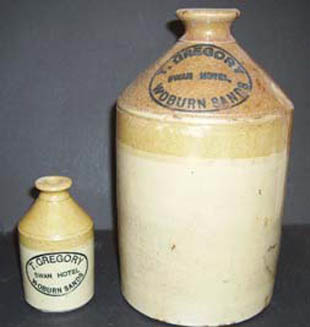
Another landlord, Robert Hammond, had a famous son, Thomas, who competed in long distance walking events. There is a page about this event elsewhere on the website. When Thomas won a world record for the distance walked in one day in 1908, his father held a smoking concert reception for him at the Swan, and this little programme for the event survives. He also advertised the inn in local guide books:
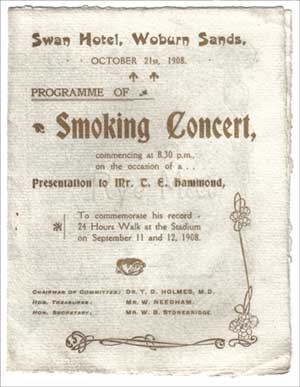
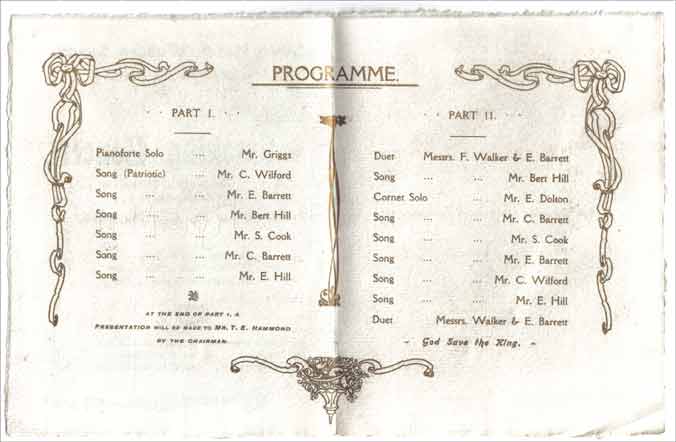
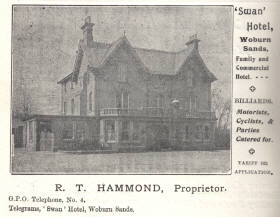
There was a major addition to the building in 1920 when the third storey bedrooms in rear were added and the bar extended. At this time the entrance to the hotel yard was from the High Street frontage, but with these alterations, the hotel and the clubroom (old school room) were connected by a wide passage, to save users having to go outdoors, and this room was the H.Q. of billiards in Woburn Sands. However, the new Club in High Street gradually took their patronage; billiards declined to such an extent that the building was closed, and came in for all sorts of usage – furniture storing etc., and Arthur Parker recalled he had also conducted furniture sales there.
When the front cart entrance was blocked, one of the outbuildings adjoining the clubroom was knocked down (one old cottage) and the entrance transferred to Hardwick Road. There was little motor traffic at that time, but with the considerable increase it became a very dangerous corner. The clubroom in its later years was the mecca of the billiards world, until the Social Club took precedence and after being used as a furniture store, it had lay idle, and was demolished in 1960. In 1962 the remainder of the buildings on the Hardwick Road frontage, together with some of the front garden of the first house in Hardwick Road, were taken down so the road junction could be widened.
Bowls were played, on and off, at the side of the Swan until the late 1960’s, but it could not compete with the well-kept green of the Social Club, and the ground became nothing but a pleasant lawn. In about 1978 the site was tarmacked over for a car park.
By 1979, only two of the old outbuildings remained, and they had been altered since the plan of 1885. The purlins and wall plates of the now demolished building were in one length of 5in. by 4in. timber, 34ft. 9in. long; an extremely long example. In pulling out a lot of the interior work, no old coins or papers were found, but in the roof of a single storey larder was a 1915 Daily Telegraph, evidently left during some small alteration in early First World War-time.
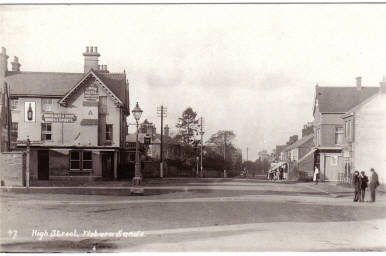
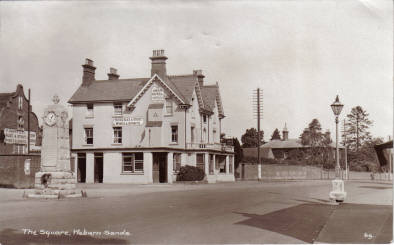
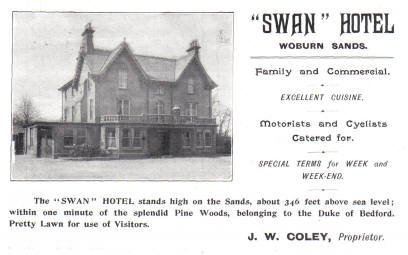
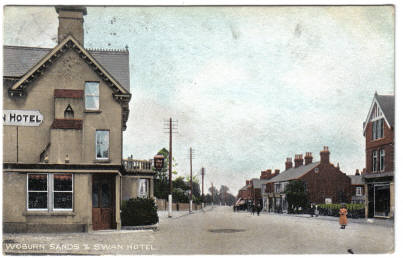
Later, when the cellars were cleared, and new lighting added, Arthur was able to inspect them. The walls of the original cellar, in stonework, were clearly definable, as a new cellar part had been added at some time. Strangely the modern cellar does not immediately adjoin the old one; there must be a filling of solid earth between them. The walls of the old building were damp, and oozing water at the base. In the West wall the old window is still there, though it is blocked with brickwork on the outside. The cill is sloped and may have been used in its day for passing down small barrels. The large beam, to the side of the step-ladder, was evidently a first-floor support, as it is morticed for joists at eighteen-inch centres.
From the layout, Arthur calculated that “…the original house was about 14 feet back to front, and double-fronted, though possibly it was three rooms long, and it would have stood back some 20 feet from the road, affording a pull-in for carts. Probably the whole was stone-built with a roof of thatch, though this may have been replaced by tiling, is unfortunate there are no old plans or pictures of the property to give a guide to at it looked like, and we can only guess.”
In the spring of 1983, considerable demolition, alteration, and additions were made to convert the property in to a Berni Inn steakhouse. At that time more old beams of the original inn were discovered; some were replaced by steel girders and some still remain. The only part of the old building remaining intact was the beer cellar.
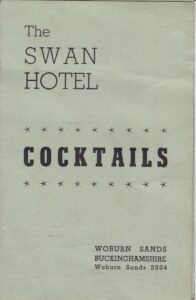
The Swan later became a Beefeater, and remains open today as part of the Mitchells & Butlers empire. When the outside was redecorated and boarded, I happened to be walking past just as the sign-writer had just finished painting “c.1910” on the outside of the building. Dismayed, I found the foreman and told him the basics of the inn’s history, so back up the ladder the sign-writer went and it now bears the year of the earliest Bucks Ale House Register entry of “c.1753”!
The Swan Field – Across the road from the Swan was Swan Field, in its time used for sports, fetes, celebrations and was even the site of Woburn Sands first visiting circus! After the death of Henry Down in 1891, Fred bought up his brother’s share. Later, he was in partnership with the local ironmonger, William Needham. Fred Down died in 1906, and Needham inherited much of the Downs business estate. He decided to develop the land, so a new road was made and plots laid out under the supervision of an architect, Grover, of Dunstable. Unlike the other side streets, this road was well made and finished with a gravelled surface and curbed sidewalks. When it was eventually taken over by the Bucks County Council, sixty years later, the granite curb was still in perfect order. To perpetuate the memory of himself and Frederick Down, William called it “Down-ham Road”, a combination of their surnames.
Landlords
The Alehouse Register entries for the inn are as follows; to which I have also added the names of licensees gathered from various other sources, including Directory entries, which can sometimes be a year or two out:
For “The Coach and Horses”:
1753-1758 Ralph French
1758-1765 John Stapp
1765-1785 Ann Stapp
1785-1793 Ann Gooding (1787 “Mrs Goodwin”)
1793-1796 Richard Higgins
1796-1800 Charles Brown
1800-1801 William Higgins
1801-1809 Richard Higgins
For “The Swan”:
1806-1821 Richard Higgins
1821-1824 Thomas Higgins
1824-1827 Thomas Worley
1837-1849 Thomas Odams, junr.
1849-1851 Edward Emerton
1851 George Handscomb
1854-1863 Richard Deverell
1864 John Goodall
1864-1871 William Scriviner
1871-1875 George Claridge
1875-1877 Zachariah Spreckley
1879 William Hodson
1881 Thomas Marshall
1881 Charles Higgins
1885 George Labrum
1886-1888 William Dilly
1890 Eliza Dilby (Dilly? Possibly widow of above?)
1894 Ernest Bull
1895 A. Nash
1896-1902 Thomas Gregory
1902-1906 John William Coley
1906-1911 Robert Thomas Hammond (from Three Cranes, Turvey)
1911-1935 Henry C. H. Saunders
1938 J. R. Thomas
1939-1940 Richard Summers
1941-1945 William James Clark
1945-1950 Henry George Quarry
1950-1953 Mrs Quarry
1953 A. S. Carlisle (from The Royal Oak, Aspley Heath)
1956 John Haynes
…and many more since.
Owners
????-1870 Higgins family
1870-1872 Charles Claridge
1872-1891 The Down Brothers
1891-1895 Down & Needham
1895-1960 Phipps & Co, Northampton
1960- Watney Mann Ltd
2016 Mitchells & Butlers
Page last updated Jan. 2022.
